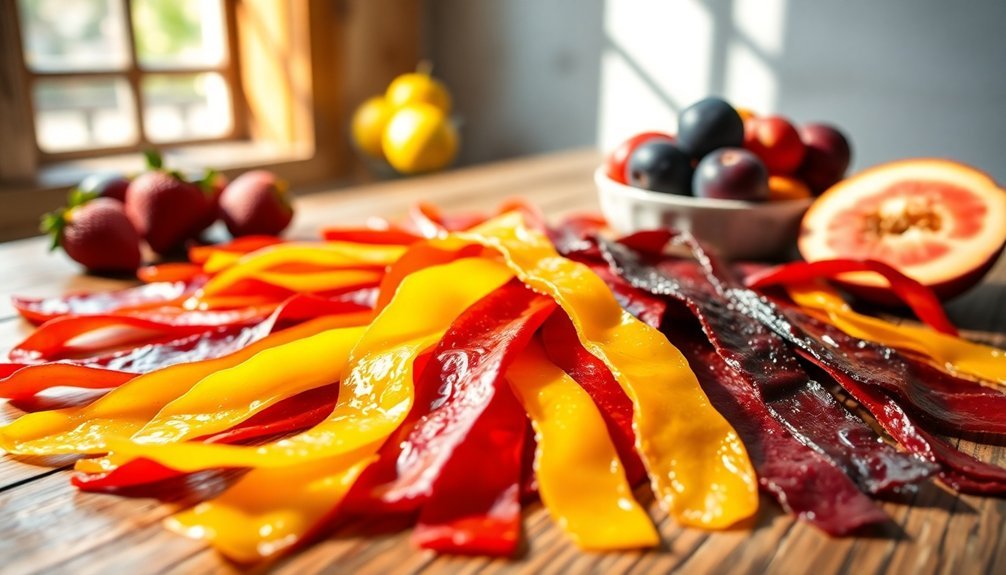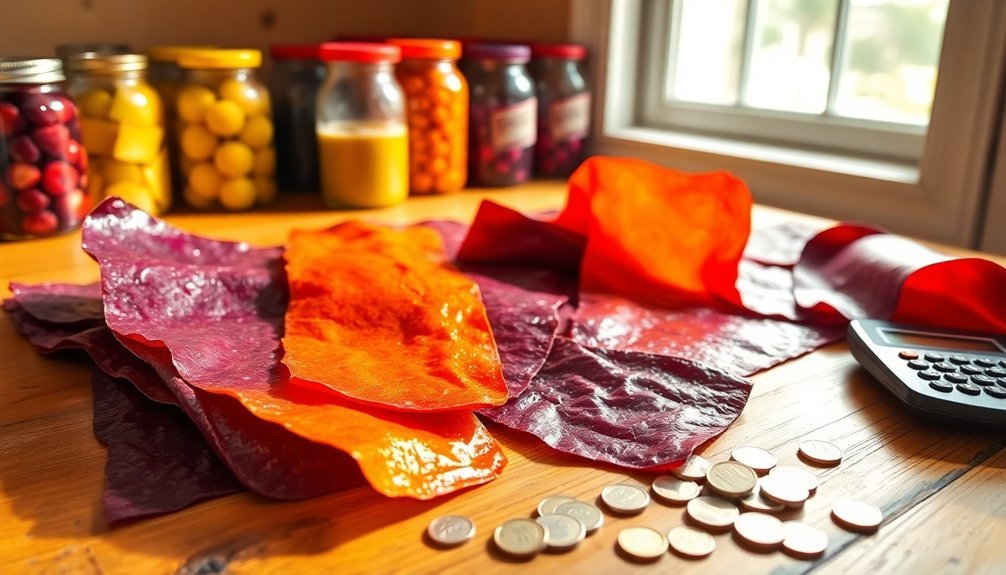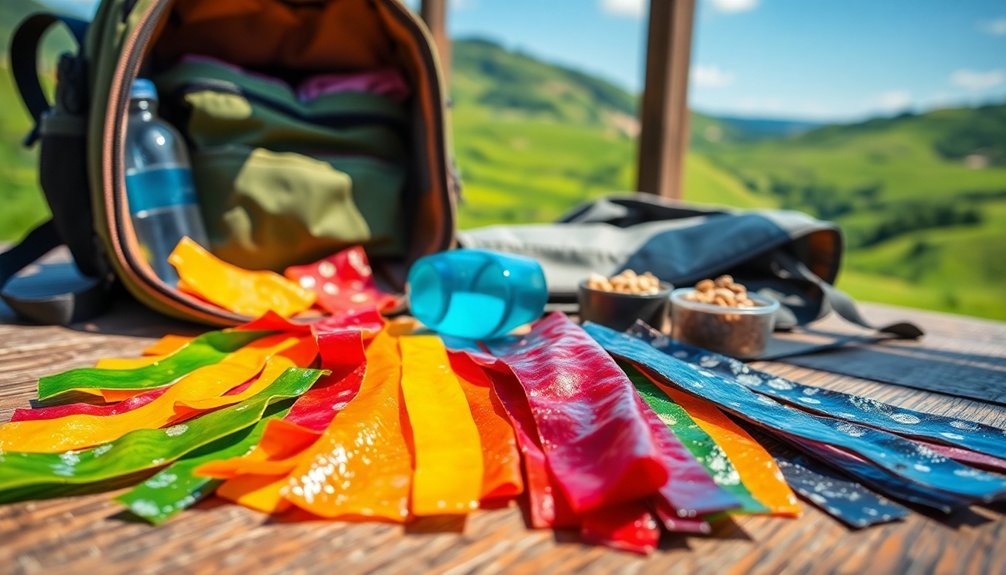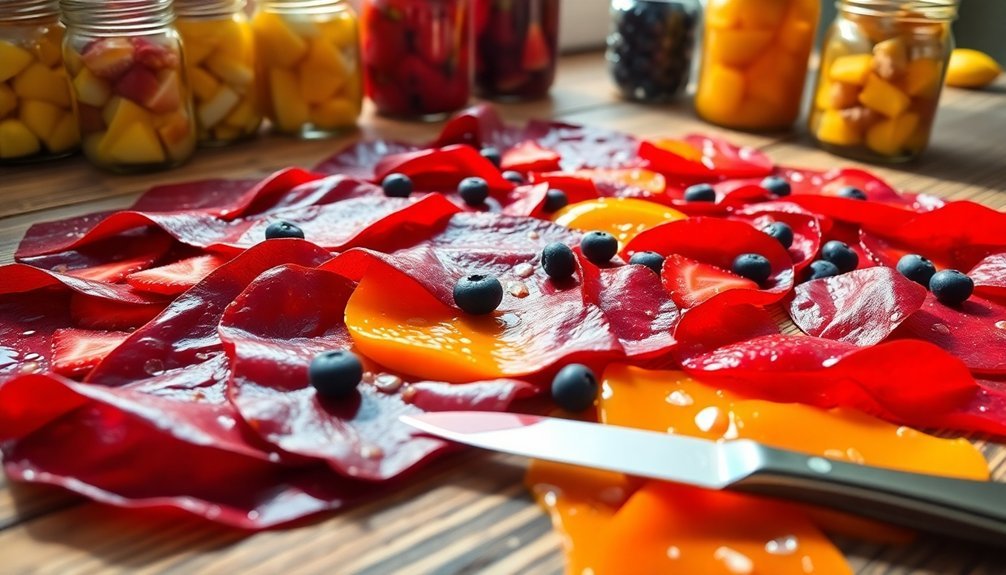Making fruit leather instead of canning gives you a healthier, customizable alternative to preserve your fruits. You control the ingredients, avoiding additives and refined sugars while enhancing flavors with spices and natural sweeteners. The dehydration process retains more nutrients, offering a snack rich in vitamins and fiber. Plus, fruit leather has a longer shelf life and is lightweight, making it perfect for on-the-go munching. It also helps reduce food waste by utilizing fruit scraps, promoting sustainability. This delicious treat not only satisfies your cravings but also supports your well-being. Keep exploring, and you might uncover even more benefits!
Nutritional Advantages of Fruit Leather

Have you ever thought about the nutritional benefits of fruit leather? This tasty snack is made from real fruit, meaning it retains many vitamins and minerals found in fresh produce. You'll find it rich in Vitamin C, which helps boost your immune system and promotes healthy skin.
Plus, fruit leather contains antioxidants that protect your body from free radicals and reduce inflammation.
With its high dietary fiber content, fruit leather supports digestive health and keeps you feeling full longer, making it a smart choice for snacking. Additionally, fruit leather is a naturally sweet option that satisfies sweet cravings without the negative effects of refined sugar.
Unlike store-bought options that are often packed with added sugar and preservatives, fruit leather minimizes these unhealthy ingredients, allowing for the natural sweetness of the fruits to shine. This helps curb sugar cravings and provides a low-calorie alternative that can aid in weight management.
The dehydration process used to make fruit leather also preserves its nutrients, as it minimizes nutrient loss by using lower temperatures.
When stored properly, it can last for weeks or even months, making it a convenient, nutrient-rich snack for various occasions.
Control Over Ingredients
When you make your own fruit leather, you've got complete control over the ingredients, allowing for a healthier and more personalized snack. You can choose fresh or canned fruit, ensuring the best flavor and nutrition. Fresh fruit lets you mix various types, while canned options save time without sacrificing health—just avoid syrup! Additionally, using leftover fruit pulp from jelly-making can further reduce waste and enhance your fruit leather's flavor.
You also get to decide on sweeteners and additives. Whether you prefer honey, sugar, or no sweetener at all, the choice is yours. You can even use natural options like white grape juice concentrate to enhance flavor without preservatives.
Here's a quick comparison of your ingredient options:
| Ingredient Type | Control Benefits |
|---|---|
| Fresh Fruit | Best flavor, custom mixes, added textures |
| Canned Fruit | Saves time, retains nutrients when packed in juice |
| Additives & Sweeteners | Tailor sweetness, avoid preservatives, enhance texture |
With this level of customization, you can even add health-boosting ingredients like pectin or calcium. So, when you make fruit leather, you're not just snacking; you're crafting a treat that fits your taste and health needs perfectly.
Extended Shelf Life

Extending the shelf life of your homemade fruit leather involves a few key practices that can make all the difference. First, store your fruit leather in a cool, dry place to prevent moisture exposure, which can lead to spoilage. If you want to maximize freshness, consider refrigerating it; this can extend its life to 6-12 months. For even longer storage, freezing is an option, allowing both homemade and store-bought varieties to last up to a year.
Be mindful of moisture content when dehydrating your fruit leather. Ensuring it's properly dried at the right temperature, around 135°F, inhibits unwanted microorganism growth. Using natural preservatives like lemon juice can also help, but be aware that homemade versions typically lack the added preservatives found in commercial products, resulting in a shorter shelf life. Additionally, the nutrient retention during the drying process makes fruit leathers a nutritious option for snacking.
When it comes to packaging, opt for airtight containers or sealed plastic bags to keep out moisture and contaminants. Opaque packaging can protect against light exposure, which might degrade quality over time.
Finally, handle your fruit leather minimally and inspect it periodically for any signs of spoilage to enjoy your delicious creation for as long as possible.
Practical Uses for Fruit Leather
Storing homemade fruit leather not only helps keep it fresh but also opens up a world of practical uses. Its lightweight and compact nature makes it perfect for snacks on-the-go, whether you're backpacking, hiking, or just running errands.
You can easily fold it and stash it in a pocket or hip belt, and since it doesn't require refrigeration for short-term use, it's an ideal travel companion.
You can also get creative in the kitchen. Rehydrate fruit leather with hot or cold water to whip up puddings or smoothies. Mix it with yogurt, nuts, or granola for an extra flavor kick.
With a variety of fruits available, you can create unique blends or spice it up with ginger or mint.
Making fruit leather is straightforward—it just requires pureeing and dehydrating fruit, no specialized canning equipment needed. You can prepare large batches and store them in airtight containers or zip-top bags to keep them fresh.
Just be sure to check periodically for signs of spoilage. With these practical uses, homemade fruit leather proves to be a flexible and convenient snack option!
Health Benefits of Homemade Snacks

Homemade snacks, like fruit leather, offer numerous health benefits that can enhance your overall well-being. By choosing homemade options, you can enjoy sustained energy and regulated blood sugar levels, making you feel more energized throughout the day. These snacks are often high in fiber and protein, which help manage your appetite and support weight management by reducing the likelihood of overeating.
Here's a quick look at some of the key benefits of homemade snacks:
| Benefit | Description | Examples |
|---|---|---|
| Regulates Energy | Provides sustainable energy levels | Fruit leather, whole grains |
| Manages Appetite | Helps prevent overeating and poor choices | Fiber-rich snacks |
| Provides Essential Nutrients | Rich in vitamins, minerals, and fiber | Nuts, seeds, low-fat dairy |
Sustainability and Eco-Friendliness
Sustainability is at the heart of choosing fruit leather over traditional canning methods. By utilizing waste products from fruits—like peels and pulp—you're actively reducing food waste. Instead of letting slightly overripe fruit or leftover canned items go to waste, you're upcycling them into delicious snacks, contributing to a more sustainable circular economy.
Fruit leather also has a lower environmental impact. It requires fewer natural resources and less energy compared to materials like animal leather, avoiding the resource-intensive processes associated with livestock farming. You're not just saving water; you're also sidestepping toxic chemicals often used in leather production, which helps lower your carbon footprint.
Moreover, fruit leather is biodegradable. This means you're helping to combat plastic waste and supporting biodiversity by reducing pressure on ecosystems. By choosing this cruelty-free alternative, you're also addressing ethical concerns related to animal products.
Every time you opt for fruit leather, you're promoting sustainable consumption patterns and conserving resources for future generations. Fundamentally, making fruit leather isn't just a smart choice for your health; it's a powerful step toward a more sustainable and eco-friendly lifestyle.
Cost-Effectiveness Compared to Canning

When comparing the cost-effectiveness of fruit leather to canning, you'll find that both methods have their advantages, but fruit leather often comes out ahead in several key areas.
First, while dehydrators may initially cost more than basic canning equipment, they pay off over time with repeated use and lower maintenance costs. You can often find both dehydrators and canners at thrift stores or garage sales, making them more accessible.
In terms of energy use, dehydrating fruit typically consumes less energy than the intense processes involved in canning. Dehydrating takes longer, but the energy is spread out over those hours, unlike the quick, high-energy bursts needed for canning.
When it comes to storage, fruit leathers are lightweight and occupy minimal space, while canned goods require more room and specific conditions.
Packaging for fruit leathers also costs less, as simple wraps or parchment paper suffice. Though canned fruits can be a great ingredient for making fruit leather, the overall costs—including ingredients—often favor fruit leather, especially if you use fruits during peak seasons.
Ultimately, fruit leather is a smart choice for cost-conscious food preservation.
Flavor Customization Options
When making fruit leather, you've got the freedom to mix various fruits for unique flavor combinations that suit your taste.
You can also spice things up by adding herbs or spices, enhancing the overall experience.
Don't forget to adjust the sweetness level to match your preference, creating a treat that's just right for you.
Unique Fruit Combinations
Exploring unique fruit combinations can elevate your fruit leather-making experience, offering endless flavor customization options. Start with versatile choices like berries—strawberries, blueberries, raspberries, and blackberries—either individually or mixed for delightful results.
Stone fruits, such as apricots and peaches, pair beautifully, while tropical options like mango and pineapple add an invigorating twist. You can create stunning effects by combining peaches with raspberries for a marbled look.
For a tropical flavor, mix citrus, kiwi, and pineapple, maybe even adding a splash of coconut milk. If you're after something revitalizing, try blackberry, mint, and lime. For a unique herbal touch, strawberries and raspberries with basil work wonders.
Consider using various states of fruit to enhance flavor. Overripe fruits are especially suited for leather, reducing waste while adding sweetness. Mixing fresh and frozen fruits can improve texture, and canned fruits can be utilized after draining.
Spice and Flavor Additions
Enhancing your fruit leather with the right spices and flavors can truly elevate your creation. Start by experimenting with spices like allspice, which adds a warm sweetness, or cinnamon for that comforting touch.
If you're feeling adventurous, try a hint of ginger for an invigorating kick or a dash of cloves—just remember to use it sparingly due to its strong flavor.
Flavor extracts and juices can also transform your fruit leather. A splash of lemon or lime juice not only adds a revitalizing zest but helps maintain the vibrant color of your fruits.
Almond or orange extract can infuse a delightful nutty or citrusy note, while vanilla extract lends a creamy sweetness.
Don't forget about other flavorings! Fresh mint can bring a cool twist, and pumpkin pie spice is perfect for a seasonal treat.
For an unexpected kick, try Tajin seasoning to add a spicy, tangy flair.
When adding these flavors, start small—about 1/8 teaspoon of spice or extract per two cups of puree. Mix well and adjust to your taste, ensuring the final product complements the natural flavors of your fruits beautifully.
Sweetness Level Adjustments
Customizing the sweetness level of your fruit leather can greatly impact its overall flavor and enjoyment. You have several options for sweeteners, like honey or maple syrup, which add stickiness and can enhance texture.
If you prefer granulated or brown sugar, verify it dissolves well in your fruit puree to avoid any gritty bits. For those watching their sugar intake, alternative sweeteners like stevia or monk fruit powder can also work, but make certain to blend them thoroughly.
Start by adding sweeteners in small amounts—about one tablespoon at a time—and taste as you go. If your fruit is naturally sweet, you might even skip additional sweeteners altogether. Mixing sweeter and tart fruits can create a balanced flavor, so consider pairing apples with berries or strawberries with rhubarb.
Keep an eye on the texture; too much liquid sweetener can make your leather sticky, while granulated sugar may form crystals over time. Aim for an even distribution of sweetness to maintain that desirable leathery texture.
With these adjustments, you'll create a fruit leather that's perfectly tailored to your taste!
Easy Preparation Process

Often, making fruit leather is a straightforward process that anyone can tackle at home. You only need a few simple ingredients and equipment to get started. Here's how to prepare your delicious fruit leather:
- Fresh, ripe fruits of your choice (like strawberries or mangoes)
- Optional sweetener (honey or maple syrup for added sweetness)
- A saucepan for cooking the fruits
- A blender or food processor for pureeing
- A baking sheet lined with parchment paper
First, rinse your fruits and prepare them by peeling, coring, and removing seeds. Cut them into small pieces to speed up cooking. Cook the fruits in a saucepan over low to medium heat until they soften and release their juices.
Blend the cooked fruits into a smooth puree, adding sweetener or lemon juice if you want.
Next, preheat your oven to its lowest temperature. Spread the puree evenly on your baking sheet and prop the oven door open slightly to let moisture escape.
In about 4-6 hours, your fruit leather will be ready! Once cooled, peel it off, cut it into strips, and store it in an airtight container. Enjoy your homemade snack!
Reducing Food Waste
When you repurpose overripe fruits into fruit leather, you're not just saving those fruits from the trash; you're also minimizing kitchen scraps.
This eco-friendly snack solution lets you enjoy delicious treats while actively reducing food waste.
Repurposing Overripe Fruits
Many people face the challenge of dealing with overripe fruits that often go to waste. Instead of tossing them out, why not transform them into delicious fruit leathers?
This simple process helps reduce food waste while offering a tasty, nutritious snack. Overripe fruits, which are often too soft for fresh eating, still pack a nutritional punch and can be creatively repurposed.
Here are some benefits of making fruit leather from overripe fruits:
- It saves money by preventing waste.
- You can use a variety of fruits, even those that may look imperfect.
- It allows you to enjoy seasonal fruits all year round.
- It's a fun and engaging activity for kids in the kitchen.
- You can customize flavors by combining different fruits or sweeteners.
Minimizing Kitchen Scraps
Repurposing overripe fruits into fruit leathers is an excellent way to minimize kitchen scraps and reduce food waste. Did you know nearly 60 million tons of food are discarded in the U.S. every year? That's about 40 percent of our entire food supply!
Converting leftover canned fruit and slightly overripe fresh fruit into fruit leathers helps you utilize what would otherwise spoil, keeping it out of landfills where food makes up 22 percent of municipal solid waste.
When you make fruit leather, you effectively extend the shelf life of your fruit—storing it for up to a month at room temperature or a year when frozen. This method not only reduces the 325 pounds of food waste generated per person annually but also contributes to fighting climate change.
By turning excess fruit into snacks, you're tackling waste management issues while enjoying a delicious treat.
With just a dehydrator or oven, you can create a convenient and portable option without needing the specialized equipment required for canning.
Eco-Friendly Snack Solutions
Eco-friendly snack solutions, like homemade fruit leathers, offer a smart way to reduce food waste while treating yourself to a delicious snack.
By using unsold or slightly overripe fruit, you can turn what would otherwise be discarded into a nutritious treat. This not only mitigates the global issue of food waste but also supports a circular economy by upcycling agricultural byproducts.
Here are some benefits of making fruit leather:
- Utilizes leftover fruit that would go to waste
- Requires fewer resources than traditional leather manufacturing
- Reduces CO2 emissions markedly compared to animal leather production
- Eliminates harmful chemicals often found in animal leather tanning
- Provides a cruelty-free alternative that promotes ethical consumption
Travel-Friendly Snack Option

When you're on the go, finding the right snack can make all the difference, and fruit leather stands out as a top choice. Its lightweight and compact packaging makes it easy to toss into your backpack or travel bag, and since it doesn't require refrigeration, you can store it at room temperature without any hassle.
Plus, you won't have to worry about leaks or spills, which is a common issue with canned goods.
Fruit leather's long shelf life is another major advantage, lasting weeks or even months when stored properly. This is perfect for extended trips or outdoor adventures, as it stays edible without refrigeration. You can even plan your meals ahead of time, knowing your snacks won't spoil.
Nutritionally, fruit leather packs a punch, retaining many vitamins and minerals from fresh fruit while being rich in fiber to keep you feeling full. Its chewy texture and sweet taste make it enjoyable, and you can easily consume it in small portions while on the move.
Ultimately, fruit leather is a quiet, mess-free snack that fits seamlessly into your travel routine.
Natural Sweetness Without Additives
Often, fruit leather is celebrated for its ability to deliver natural sweetness without the need for additives. When you make your own fruit leather, you get to enjoy the full flavor of the fruits you choose, like strawberries or blueberries, which are naturally sweet enough on their own.
You won't need to add refined sugars, making this a healthier option for you and your family.
Here are some benefits of this natural sweetness:
- Pure Ingredients: You're using fresh or slightly overripe fruits, ensuring no processed ingredients or preservatives.
- No Artificial Flavorings: There's no need for artificial flavorings or additives, keeping things simple and wholesome.
- Nutrient-Rich: The drying process concentrates vitamins, minerals, and fiber, enhancing the nutritional value.
- Customizable: You can adjust the sweetness based on the fruits you use and even add a touch of honey or maple syrup if desired.
- Health-Conscious Choice: Homemade fruit leather avoids the additives often found in store-bought versions, making it a better choice for your health.
With fruit leather, you get a delicious treat that's both nutritious and satisfying!
Versatility of Fruits Used

While fruit leather is primarily known for its deliciousness, its versatility in the choice of fruits makes it a truly adaptable snack. You can use a variety of fruits such as apples, apricots, berries, cherries, and peaches. Tropical fruits like mangoes and pineapples add unique flavors and textures, while stone fruits are perfect due to their soft flesh and sweetness.
Feel free to mix different fruits to enhance flavor and texture. For example, blend strawberries with apples for moisture balance or pair mangoes with pineapple for a sweet, tropical treat. You can even incorporate bananas with berries to create a delicious combination.
The beauty of fruit leather lies in the states of fruit you can use. Whether fresh, canned, cooked, or frozen, nearly any fruit can be transformed into leather. Slightly overripe fruit is particularly ideal, as it packs more flavor.
Adjust your fruit combinations based on characteristics—high-water-content fruits work best with drier ones, and fruits low in natural sugars may need a touch of sweetener. This flexibility truly makes fruit leather an exciting and versatile snack option!
Frequently Asked Questions
How Does Fruit Leather Compare to Traditional Canning in Taste?
Fruit leather retains vibrant, fresh flavors by avoiding high heat, while canned fruits often lose taste and texture. You'll enjoy the chewy consistency and natural sweetness of fruit leather, enhancing your snacking experience considerably.
What Equipment Is Needed to Make Fruit Leather at Home?
To make fruit leather at home, you'll need a blender, baking sheet or dehydrator, parchment paper, and an oven. Optional tools include a colander, measuring cups, and airtight containers for storage. Enjoy the process!
Can I Use Frozen Fruit for Making Fruit Leather?
Yes, you can use frozen fruit for making fruit leather. Just thaw and drain it first. Mixing it with fresh fruit or applesauce can enhance the texture and flavor of your fruit leather.
How Do I Know When Fruit Leather Is Properly Dried?
To know when your fruit leather's properly dried, check for slight tackiness, flexibility, and no wet spots. Press the center; it shouldn't leave an indentation. If it peels off easily, it's ready!
Is Fruit Leather Suitable for People With Dietary Restrictions?
Yes, fruit leather can be suitable for various dietary restrictions. You can control ingredients, avoid added sugars, and guarantee it's gluten-free or vegan by making it at home, tailoring it to your specific needs.
In Summary
Making fruit leather instead of canning offers you a delicious way to enjoy fruits while maximizing their nutritional benefits. You gain full control over ingredients, ensuring no unwanted additives, and you'll find it easy to reduce food waste. Plus, fruit leather is a travel-friendly snack that's naturally sweet and versatile. Whether you're hiking or just craving a treat, you'll appreciate the health benefits of this homemade option. So, give it a try and enjoy your tasty creations!





Leave a Reply